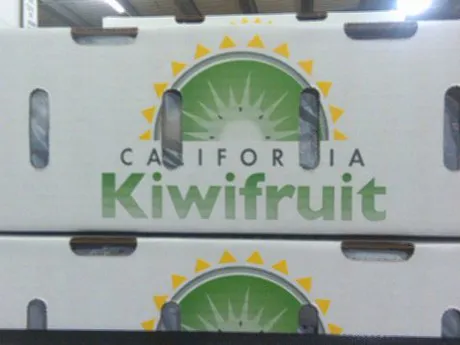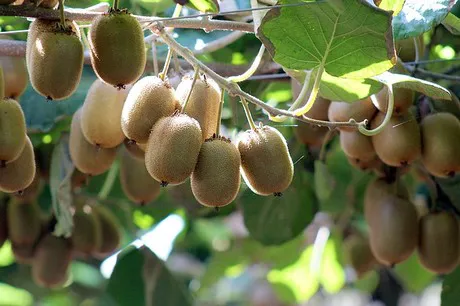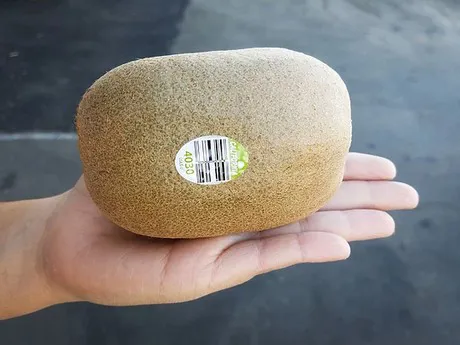With just over half of the California kiwifruit crop yet to be shipped, kiwifruit growers are on track for a decent sized crop this year. According to the California Kiwifruit Commission, just over 3.6 Million 9kg boxes of green kiwifruit has been shipped so far, leaving around 55 percent of the crop remaining.
"Including all varieties, the state has produced between 10 - 11 Million boxes of kiwifruit this past season, which is a decent sized crop when compared with the long term average," noted Nick Matteis of the California Kiwifruit Commission. "The harvest typically occurs from late September to early or mid-November, depending on the weather, with the packing season lasting around six months."
Matteis said that one notable aspect of this season's crop is the size profile, with an impressive amount of the preferred larger sizes. "The size profile has been exceptional this year. The majority of the crop is in the 18, 20 and 30 series - which are generally the larger fruit sizes. These sizes are preferable for retailers and more marketable for both the bulk and consumer package market. The quality has also been quite outstanding. As a result, the season has started out well."
"For organic, the industry is sitting at 357,000 boxes out of the total 3.6 Million," he continued. "Organic is interesting because it tends to be shipped for a longer window, and at this stage there is 62 percent of the organic crop yet to be shipped for the season."

Prices on a gradual upward trend
The market for kiwifruit has been quite steady for the most part. Prices on the domestic market began on the lower end of the average but for the most part have since steadily climbed. This is in comparison with the previous year's crop which saw high prices from the outset that quickly diminished.
"This year we started significantly lower than last year," Matteis observed. "However, the 2017/18 crop started with unusually high prices that quickly dropped down after the first few weeks. This season started around the $16 mark for conventional Hayward varieties, but have since been steady around $17. It has been a gradual upward trend with a few highs and lows."
He added that exports have generally been performing well, with Japan having a notably strong year. "Most of the crop goes to the US domestic market, but our largest export market is Mexico. This year we shipped considerably more to Japan than previous years and it has been our second largest export market this season, followed closely by Canada and Taiwan. Each year we see some interesting movements in regards to exports to each country and this is dependent on a number of factors, including fruit sizing."

Gold and "Mega" Kiwis generating great interest
The Hayward kiwi variety makes up the greatest percentage of the California crop. Acreage on gold kiwifruit however, continues to grow and more trees are maturing. As a result, the volume of gold kiwifruit has substantially increased in the last few years.
"We have some gold varieties in California that seem to be doing very well," Matteis shared. "We have seen a doubling in volume and there is still some acreage yet to mature. Demand is good as the gold variety eats very well. They need to be grown a little differently so it will be exciting for the category if this continues to go well."
Another variety that is expanding its presence in California is the "Mega Kiwi". As the name suggests, the Mega Kiwi is much larger than the typical kiwifruit seen in stores. Originally from Greece, it's now being grown in California with much success, according to Matteis. "We are also seeing more volume of the Mega Kiwis. The size of these are off the charts, with sizing profiles of up to 11 not uncommon. The great thing about these is that there is no loss of sugar - they taste just as good as the regular-sized kiwifruit. They're also simply fun to look at and just like the gold kiwifruit, we are expecting more acreage to mature over the next year or two."

Image: Mega Kiwi Company
New kiwifruit assessment rate
Lastly, the Commission has also decreased its per volume fill assessment rate from $.040 to $.025 per 9-kilo volume-fill container or equivalent of kiwifruit handled, effective January 25. According to the Commission, it's simply a function of the anticipated lower expenditure this year as well as the fact there is a larger crop.
"This is a typical adjustment to make sure the budget is in line with expected annual expenditures," Matteis explained. "Part of the reason for the lower rate is the larger crop produced this year and as a result the Commission, along with the USDA, has approved the lower assessment rate."
For more information:
Nick Matteis
California Kiwifruit Commission
Ph: +1 (916) 441-0678
[email protected]
www.kiwifruit.org
